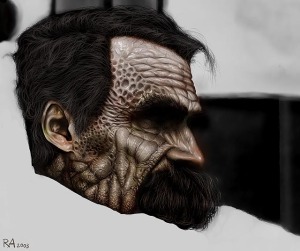Propaganda is, of course, largely, probably wholly, concerned with the manipulation of symbols in order to cause a change in behavior. This distinguishes it from other ways of influencing behavior, such as physical coercion. Unlike physical coercion, however, whose effects usually fade when the source of coercion is taken away, propaganda can have lasting effects – because it manipulates the symbols our brains use to make sense of the world. It rewires synapses.
The other difference between propaganda and physical coercion is that the engine of propaganda – the vital force from which it derives its power – can be either love or fear. Coercion uses only fear.
For this essay, I’ll define love as a force that reinforces reality and moves us toward living in harmony with reality. Fear, the source of neuroses and other maladaptations to reality, does the opposite. It causes us to believe in lies.
Which brings me to what I’d like to write about: the beneficent use of symbols, of which religion, particularly the Catholic Church, is the prime source. Indeed, the use of symbols to communicate ineffable truths seems to have been invented by religion. (Being merchants, the Phoenicians, inventors of our most ubiquitous symbols, the phonetic alphabet, were largely concerned with keeping track of material goods. Of course, most modern propaganda is concerned with the same thing.)
The Catholic Church’s loving use of symbols to communicate ineffable facts about reality came home to me this Easter season. We (I am a Catholic) celebrate Easter over three days, which is called the Easter Triduum. On Holy Thursday, or Maundy Thursday to Anglicans, the pastor washes the feet of people who are joining the Church, mimicking what Christ did for the Apostles at the Last Supper. This is an incredibly powerful symbol of the paradoxical source of Christ’s power, i.e., the power of abdicating physical power, the power of humility.
As others, such as Ghandi and Martin Luther King have proven, the paradoxical power of humility can change nations – and in a lasting way, unlike physical coercion, i.e., war, which inevitably leads to more war. (Note: I am not a pacifist and believe in the concept of just war, and in the honorable and courageous conduct of my sons, who are just warriors.)
It’s interesting that Nietzsche, who called Christianity a ‘slave religion’ because of its paradoxical celebration of humility vs. Greek mythology’s more rational celebration of physical power, died young in an insane asylum. Though Nietzsche was certainly a brilliant man, perhaps the best writer ever to philosophize and a courageous warrior against conventional thought, my personal mythology about Nietzsche is that he lost touch with reality because he deliberately ran away from the ultimate reality communicated by Christian symbology. He embraced symbols of fear instead of love.
So, to get back to the point, some symbols are more powerful than others and the trick is to know when to use which symbol. Words are symbols, often quite powerful ones. But if our pastor has simply talked about the power of humility on Maundy Thursday, or even talked about how washing someone’s feet is a strong demonstration of humility, it would have been much less effective than simply washing someone’s feet.
There are parallels here with modern, secular propaganda techniques that use symbolic actions instead of words, such as lunch counter sit-ins.
Art, of course, is the ultimate source of effective non-verbal symbols. Christo comes to mind, with his Gates in Central Park being an excellent and recent example. And, as Christo’s name suggests, there are strong connections between art and religion. Indeed, I doubt art would exist without religion. The banality and deliberate ugliness of much modern art can probably be traced to its divorce from religion. (Note: I am a big fan of modern art, particularly abstract expressionism and field paintings, and not just from 50 years ago. Currently, Carrie McGee is doing incredible things here in Nashville. But have a look at art magazines these days to see what tripe is passing for art. Or attend the Whitney Biennial, but bring an air sickness bag. I blame it on Duchamp. If you are a genius, as he was, you can pull it off. Unfortunately, he has spawned two generations of copyists who are anything but geniuses.)
Getting back to the Triduum, the next night, Good Friday is replete with strong, non-verbal symbols. The priests begin the Mass by lying prostrate in front of the altar, another sign of humility, and, to me, of great sadness, because the greatest murder in the world’s history was committed on this day. (Of course, the world’s salvation resulted from this death – because it was followed by a resurrection – which is what makes it a Good Friday.)
At the end of the Mass on Good Friday, a cross is brought forward and all are invited to venerate it, an example of how the Church has turned a symbol of death into a symbol of life – which is proof that symbols are not immutable, and that they have no meaning outside of the history attached to them, and the interpretation of that history.
The swastika – also a type of cross – is an example of a symbol whose meaning was changed in this way, though in the opposite direction. In India, where this symbol originated, it stood for “well-being” and was a good luck charm. (Perhaps it still does. My collection of Kipling, which was published after WWI, I think, is decorated with swastikas on the spine.) Indeed, the positive, life-affirming associations with the swastika is why Hitler chose it as the symbol of Nazism. The National Socialists’ actions, which were
anything but life-affirming, turned it into a symbol of evil – probably the greatest symbol of evil in the world today, at least in the West. As the cross was probably the greatest symbol of evil in the Western World before Christ was crucified.)
All lights are extinguished in the church on Good Friday, light being a universal symbol of life and vitality. On the last day of the Triduum, the Easter Vigil or Holy Saturday, the light returns in one of the most moving uses of symbols I’ve ever witnessed – because the symbol’s effectiveness relies on the participation of everyone in the church and the way in which they participate communicates the reality behind symbol.
Here’s how it goes: The Paschal Fire (which symbolizes Christ’s resurrection) is lit outside in front of the church. All of the people have a candle. One person lights his candle form the Paschal Fire and turns to the person next to him and lights her candle. Soon, in exponential fashion, the entire congregation is holding a lit candle and as we walk into the darkened church, the darkness is driven out.
This is just scratching the surface of the many and multi-layered uses of symbols during the Easter Triduum. The cumulative effect is transforming, and it would be if not a word were spoken.
And that is fun with symbols.







